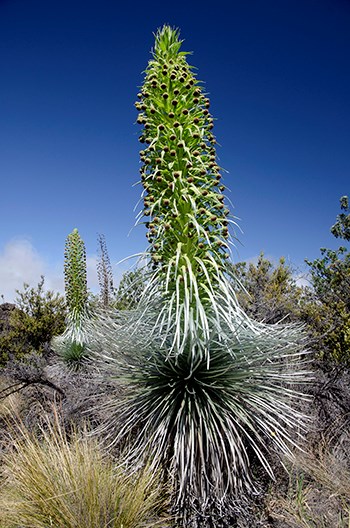
ʻĀhinahina (Mauna Loa Silverswords)One of the world's most extraordinary plants survives only on the flanks of Mauna Loa between 5,000 to 8,000 feet (1,500 to 2,500 m). 'Āhinahina are named for the remarkable shine of soft, silver hairs that cover and protect their sword-like leaves. Although they share the same ancestor, Mauna Loa silverswords are distinct from the other species found on Mauna Kea and Haleakalā. Mauna Loa silverswords generally grow fewer "petals" in their flowerheads and their thinner leaves are less hairy. Also remarkable is their life history. It is only once in their lives and only after 10 to 30 years that 'āhinahina send up a spectacular stalk of fragrant flowers as tall as 9 feet (3 meters). Within weeks it goes to seed and its life is concluded—the entire plant dies.Foraging ungulates, like cattle, sheep, and goats, love to eat silverswords and where accessible, they have devoured any they’ve found. By the early 1990s, the entire species was limited to a handful of plants clinging to survival at three remote sites on Mauna Loa. However, toiling on hard rock at high altitudes, national park crews have erected miles of fence to keep out stomping and chomping beasts. To ensure the long-term survival of 'āhinahina, a public/private partnership now collaborates to bolster silverswords' genetic diversity. Botanists painstakingly cross-pollinate wild plants, collect their seeds, and carefully germinate them in secure greenhouse. Safe inside protective fences, these beauties will soon replenish the mountain's majestic landscapes. View an interactive StoryMap above to learn how Hawaiʻi Volcanoes National Park and partners are collaborating to replenish the mountain's majestic landscapes with silverswords. Watch a short video: "Silverswords: Rarer than Diamonds" Silverswords | mp4 | QuickTime Version 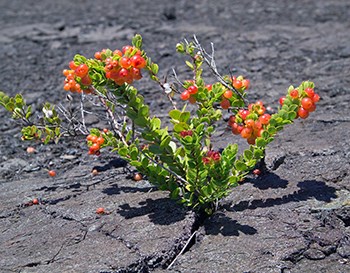
ʻŌheloʻŌhelo is notable for both its cultural significance and its importance to threatened species. Less than a few feet tall, the small shrub is most noticeable for the berries it produces. These sweet berries can range from red to yellow in color and are coveted throughout Hawaiʻi for use in foods like jams and pies. These berries are also an important food source for the nēnē, the threatened Hawaiian goose and state bird of Hawaii. Because of the dependence by the nēnē on the fruit, it is asked that people do not gather the berries in the park. There are also two species of moths found nowhere else in the world that live exclusively in ʻōhelo berries during their larval stage.As a pioneer species, it is one of the first plants to colonize new lava flows. The plant is also famously considered sacred to Pele, the Hawaiian volcano deity. In Native Hawaiian custom, it is proper to offer ʻōhelo berries to Pele before consuming any oneself. In her storied excursion to Kīlauea in 1824, Chiefess Kapiʻolani famously renounced Pele on the rim of Halemaʻumaʻu crater by eating ʻōhelo berries without an offering to the fiery deity first. There are two species of ʻōhelo within Hawai’i Volcanoes National Park, the common ʻōhelo, as well as ʻōhelo kau la’au, also known as tree ʻōhelo. 
PūkiaweThis spindly native plant is extremely versastile and widespread throughout the park. Its leaves can vary but are mostly small, narrow, and come to a sharp point. Like ʻōhelo, pūkiawe carries white or pink berries that are a popular food for the nēnē, which disperse the plant's seeds through scat. However, unlike ʻōhelo, the berries are not edible for humans. When blooming, its flowers can from range white to pale pink.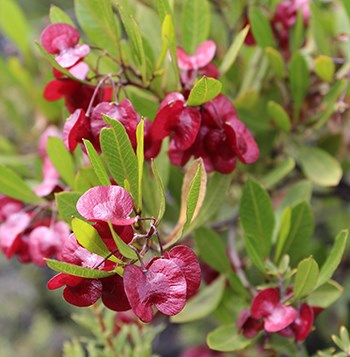
ʻAʻaliʻiʻAʻaliʻi is found in nearly every ecological zone in the national park, with the notable exceptions of extremely wet rainforest and the high alpine slopes of Mauna Loa. The most prominent features of the plant, which can appear as either a tree or shrub-like, are the colorful seed capsules. These showy seed capsules can vary greatly in appearance, but are most frequently red or purple in color. ʻAʻaliʻi is one of the few plants that is tolerant to wildfires. Look for it to be one of the first plants to move into recently burned areas, such as along Mauna Loa Road.
KūkaenēnēSeeds of this plant are commonly found in "nēnē droppings”, which accounts for its Hawaiian name. Its inner bark produces a yellow dye; its fruit, a favorite of the threatened goose, make a purple to black dye. 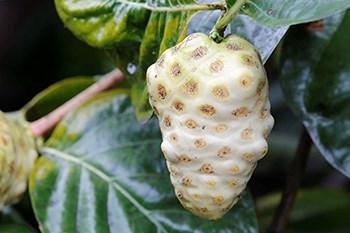
NoniNoni, also known as Indian mulberry, was brought to Hawaiʻi by early Polynesian settlers. Both red and yellow dyes are made from their roots. Largely considered an emergency food in times of famine, the foul-smelling fruit is also renowned as a cure for a variety of ailments. Look for it in coastal areas of the park. 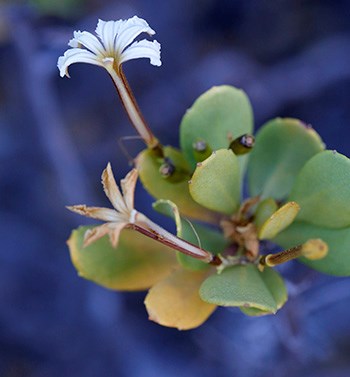
NaupakaFour species of naupaka are found in Hawaiʻi Volcanoes National Park.Naupaka kahakai, also known as beach naupaka, is one of the most visible plants on the undeveloped coastlines of Hawai’i. It has distinctive thick and glossy leaves. Like other naupaka species in the area, it has a white “half flower” that appears to be split. Its rarer counterpart, Kīlauea naupaka, is limited to the national park and the western flanks of Mauna Loa. Although it was at one time under consideration to be listed as an endangered species due to its scarcity, it is very visible in certain places along Hilina Pali Road in the park. It is a low-growing shrub with yellowish-green leaves up to three inches in length. A third species, naupaka kuahiwi, is found near the rim of Kīlauea caldera and along the east rift zone. It is larger and taller, with skinnier leaves that feature more prominent teeth than other naupaka species and comes with a beautiful fragrance. Ridgetop naupaka (Scaevola gaudichaudii) tends to favor higher elevations, so it often gets lumped in under the common name naupaka kuahiwi, but it favors drier, windier areas than other kuahiwi varieties. It blooms year round, producing either a yellow (or less commonly) pink flower. 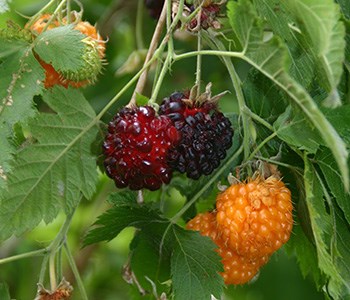
‘Ākala (Hawaiian Raspberry)Prickles on Hawaiian raspberry are absent or can usually be brushed aside. Its delectable berries can grow as large as a golf ball and its bark is made into kapa ‘ākala (pink cloth). This plant can most easily be seen in the forest around Kīpukapuaulu. 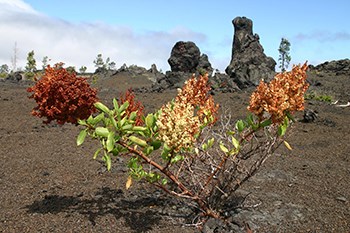
PāwalePāwale (Rumex skottsbergii), also known as lava dock, is endemic to the island of Hawaiʻi. Look for it when it is in bloom on exposed lava flow fields near Maunaulu. It has large clusters of greenish flowers and thick ovate leaves. In the Hawaiian Islands, there are three endemic species representing a single colonizing lineage. |
Last updated: June 1, 2023
